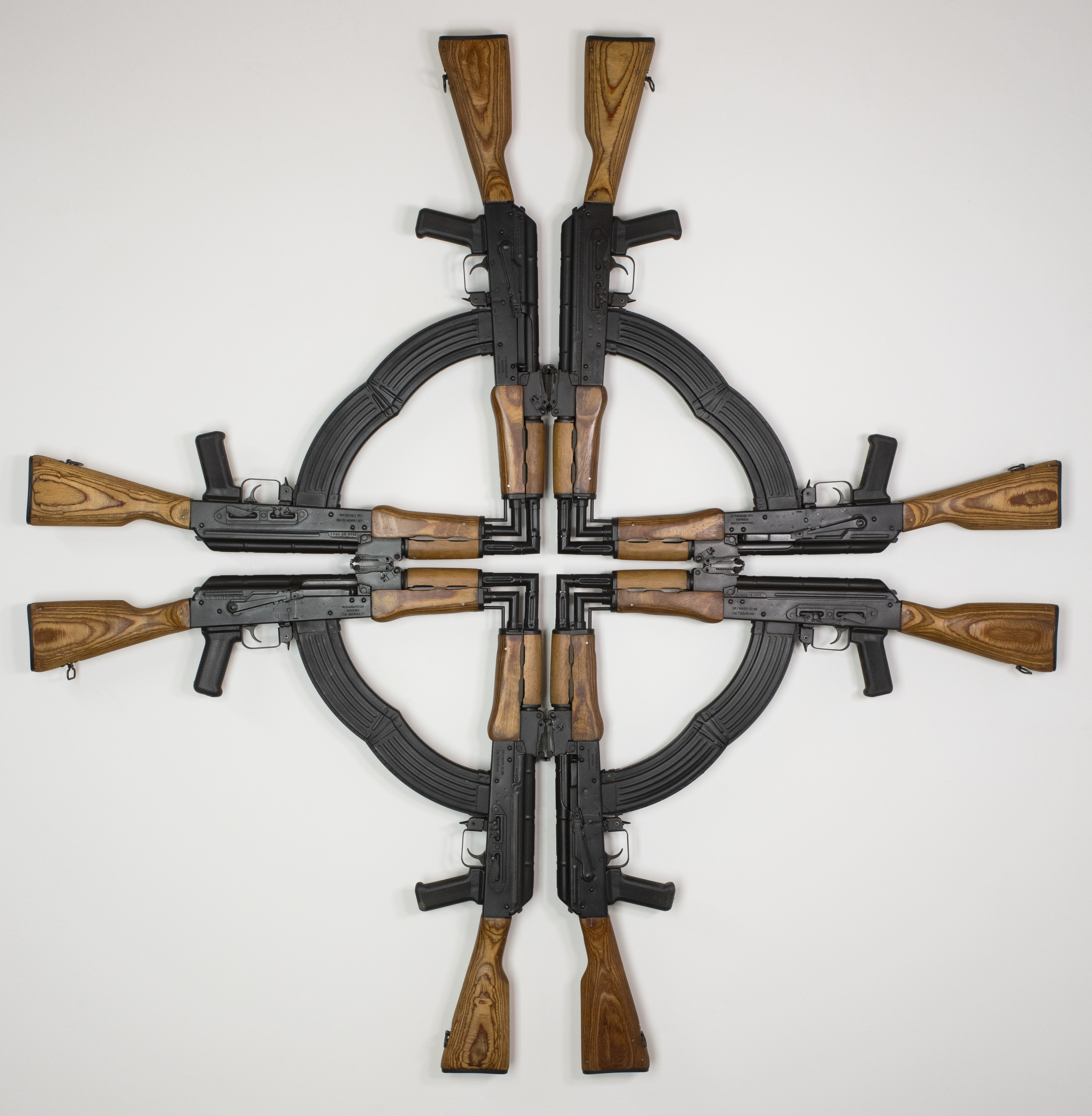
Two Grains of Wheat
Curated by Sara Reisman601Artspace, 88 Eldridge Street
April 22 - July 2, 2023
View installation images of the exhibition
Related Readings:
Olu Oguibe, A Monument for Strangers and Refugees (2017) – Press Coverage
Pamela Valfer, In Situ: A Memorial to a Memorial (2019) – Artist Statement
Hinda Weiss, Among Graves and Ruins (2019) – Reference Guide
John Ahearn and Rigoberto Torres
Mel Chin
Zachary Fabri
Baseera Khan
Joseph Liatela
Dante Migone-Ojeda
Olu Oguibe
Sina Rockensüß
Jorge Luis Rodriguez
Pamela Valfer
Mierle Laderman Ukeles
Hinda Weiss
On Presence: Joseph Lietala and Zachary Fabri in conversation with Sara Reisman
601Artspace is delighted to present Two Grains of Wheat, an exhibition that explores how contemporary artists engage with spirituality and religious symbolism in their work, especially in times of political upheaval. The exhibition encompasses performative gestures, devotional objects, monuments, ruins, and text-based works that use religious references to promote ideals of justice. The artworks expand our understanding of faith, spirituality, and religion–related but distinct concepts that inform both collective and individual identity.
Mel Chin’s Cross for the Unforgiven (2002) is a sculpture made from eight AK-47 rifles that have been fused together into the form of a Maltese cross from the Crusades, a symbol of religious intolerance and violence. A tapestry by Baseera Khan, titled Muslims=America (2022) is based on the poster she created for the Jewish Museum in 2019 to create a cultural bridge between faiths, and, according to the artist, could be redeployed in the event of another Muslim travel ban. Jorge Luis Rodriguez’s Labyrinth/Laberinto (1979) is one of a series of his maze-like sculptures symbolizing paths embedded in the floors of churches intended to guide those making pilgrimages. Situated in the center of the exhibition, these labyrinths rework and re-situate the paths proscribed by institutional religious practice. Dante Migone-Ojeda’s Amaru (2022), made of stone, skull, hands, and beads, is a shrine-like assemblage referencing the religious syncretism indigenous to Caribbean and Latin American cultures.
Central to the exhibition’s conceptual framework is ephemera from Olu Oguibe’s A Monument for Strangers and Refugees, an imposing obelisk that was publicly installed in Kassel, Germany for the 14th edition of documenta in 2017. A call to action in the face of the Syrian refugee crisis, the work was inscribed with biblical text from the Gospel of Matthew welcoming asylum seekers in four languages. This monument inspired Pamela Valfer to create In Situ: A Memorial to a Memorial (2019), site-responsive rubbings of the texts etched into Oguibe’s structure. Valfer created her rubbings amidst controversy, as community members in Kassel protested the monument’s long-term installation. The political tension over this work of art highlighted the convoluted relationship between religion and politics in the face of a human rights crisis. Another response to Oguibe’s obelisk is a book project by Kassel-based artist Sina Rockensüß, who mixes archival text and images to reflect on the local community’s support of and opposition to the artwork. The remnants of this monument and Valfer’s rubbings are positioned in dialogue with Among Graves and Ruins (2019), Hinda Weiss’ multi-channel video of the surreal landscape within and around the Rockefeller Museum in Jerusalem, founded in 1938 as the Palestine Archeological Museum. Shot within a holy site, Weiss’ video collage of the shattered remains of religious conflict echoes Oguibe’s call for sanctuary over the fortification of borders.
In his 2022 project To Move is to Remember, Joseph Liatela created a stage for performers to process the collective trauma experienced in the 2016 mass shooting at the Pulse nightclub in Orlando. Liatela’s devotional objects and corporeal imprints of gold residue allude to the spiritual aspects of club culture, including the sanctuary of chosen family. John Ahearn and Rigoberto Torres’ decades-long collaboration has produced iconic “life cast” sculptural portraits of residents from the Bronx. Originally placed on building exteriors, the sculptures’ saintly presence demonstrates how the aura emanating from art is not so different than that of religious icons.
A follow-up to Mierle Laderman Ukeles’ 1979 letter Dear Sanman, A Whole World, 1979/2023 pays homage to the daily labor of care performed by NYC sanitation workers. Ukeles’ outsized letter introduces Touch Sanitation, a performance work in which she personally traveled the city’s boroughs shaking the hands of each sanitation worker and thanking them for keeping New York City alive. Ukeles’ project evokes the Jewish spiritual concept of Tikkun Olam, which translates to ‘repairing the world.’ Staged as choreography in public space, Zachary Fabri’s Mourning Stutter (2017/2022) is an abstracted expression of his assertion that “the black community is in a state of perpetual mourning, specifically related to the violence of policing and white supremacy.” Fabri’s performance holds space for unabashed joy, reminding us of the possibility for movement to render otherwise inhospitable public spaces spiritually transcendent.
Image: Mel Chin, Cross for the Unforgiven, 2022. AK-47 assault rifles (cut and welded)
54 x 54 x 3 inches. Photograph by Grace Clark.
Hinda Weiss’ Among Graves and Ruins is presented with the support of Artis.
88 Eldridge St. New York, NY 10002
Tel: 212-243-2735
Open Thurs-Sun 1-6pm
© 601Artspace, 2018
